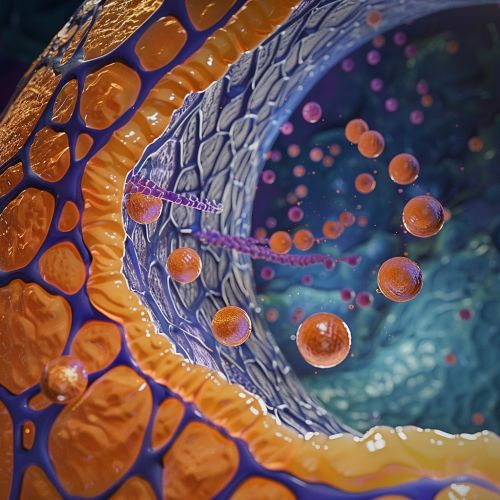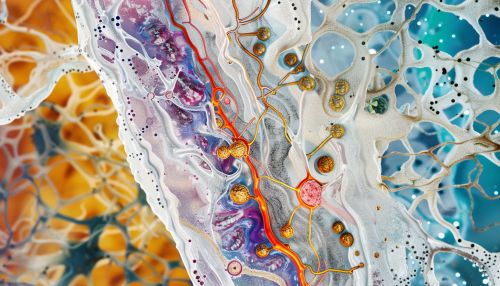Oxylipin: Difference between revisions
No edit summary |
No edit summary |
||
| Line 5: | Line 5: | ||
Oxylipins are derived from PUFAs through a process called [[Oxidative Stress|oxidative]] enzymatic reactions. The most common PUFAs that serve as precursors for oxylipins are arachidonic acid (AA), eicosapentaenoic acid (EPA), and docosahexaenoic acid (DHA). These PUFAs are first released from the cell membrane by the action of phospholipase A2 (PLA2), and then they are converted into oxylipins by three main enzymatic pathways: the cyclooxygenase (COX) pathway, the lipoxygenase (LOX) pathway, and the cytochrome P450 (CYP) pathway. | Oxylipins are derived from PUFAs through a process called [[Oxidative Stress|oxidative]] enzymatic reactions. The most common PUFAs that serve as precursors for oxylipins are arachidonic acid (AA), eicosapentaenoic acid (EPA), and docosahexaenoic acid (DHA). These PUFAs are first released from the cell membrane by the action of phospholipase A2 (PLA2), and then they are converted into oxylipins by three main enzymatic pathways: the cyclooxygenase (COX) pathway, the lipoxygenase (LOX) pathway, and the cytochrome P450 (CYP) pathway. | ||
[[Image:Detail-77705.jpg|thumb|center|A microscopic view of a cell showing the enzymatic pathways of oxylipin synthesis.]] | [[Image:Detail-77705.jpg|thumb|center|A microscopic view of a cell showing the enzymatic pathways of oxylipin synthesis.|class=only_on_mobile]] | ||
[[Image:Detail-77706.jpg|thumb|center|A microscopic view of a cell showing the enzymatic pathways of oxylipin synthesis.|class=only_on_desktop]] | |||
== Biological Functions == | == Biological Functions == | ||
Latest revision as of 07:12, 7 May 2024
Introduction
Oxylipins are a large and diverse group of lipid metabolites derived from the oxygenation of polyunsaturated fatty acids (PUFAs). They are involved in a wide array of biological processes, including inflammation, immunity, and cell signaling. Oxylipins are produced in most tissues and are found in both plants and animals.
Structure and Synthesis
Oxylipins are derived from PUFAs through a process called oxidative enzymatic reactions. The most common PUFAs that serve as precursors for oxylipins are arachidonic acid (AA), eicosapentaenoic acid (EPA), and docosahexaenoic acid (DHA). These PUFAs are first released from the cell membrane by the action of phospholipase A2 (PLA2), and then they are converted into oxylipins by three main enzymatic pathways: the cyclooxygenase (COX) pathway, the lipoxygenase (LOX) pathway, and the cytochrome P450 (CYP) pathway.


Biological Functions
Oxylipins play crucial roles in various biological functions. They are involved in the regulation of inflammation and immune responses. For instance, some oxylipins, such as prostaglandins and leukotrienes, are potent mediators of inflammation. They are also involved in cell signaling, where they act as second messengers to regulate cellular functions. Moreover, oxylipins have been implicated in various diseases, including cardiovascular diseases, cancer, and neurodegenerative diseases.
Role in Diseases
Research has shown that oxylipins are involved in the pathogenesis of various diseases. For example, in cardiovascular diseases, oxylipins can regulate blood pressure, platelet aggregation, and vascular tone. In cancer, oxylipins can promote or inhibit tumor growth and metastasis. In neurodegenerative diseases, oxylipins can modulate neuronal function and inflammation. Therefore, understanding the roles of oxylipins in diseases can provide insights into disease mechanisms and potential therapeutic strategies.
Therapeutic Potential
Due to their involvement in various diseases, oxylipins have been considered as potential therapeutic targets. For instance, drugs that inhibit the synthesis of pro-inflammatory oxylipins, such as nonsteroidal anti-inflammatory drugs (NSAIDs), have been widely used for the treatment of inflammatory diseases. Moreover, dietary supplementation with PUFAs, the precursors of oxylipins, has been suggested to have health benefits, such as reducing the risk of cardiovascular diseases.
Future Directions
Despite the significant progress in oxylipin research, many questions remain to be answered. For example, the roles of many oxylipins in health and disease are still not fully understood. Moreover, the interplay between different oxylipins and their synergistic or antagonistic effects are largely unknown. Therefore, future research is needed to further elucidate the biology of oxylipins and their potential as therapeutic targets.
